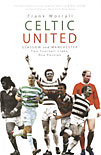 Glasgow and Manchester – Two Football Clubs, One Passion
Glasgow and Manchester – Two Football Clubs, One Passion
by Frank Worrall
Mainstream, £9.99
Reviewed by Jonathan O'Brien
From WSC 253 March 2008
Two bad books mashed into one inedible puree of diametrically opposed flavours, Celtic United is the literary equivalent of one of those garish scarves you see being waved at European fixtures between Celtic and any English side, with half the garment taken up with their name rendered in green and white, and the other half bearing the name of their opponents, usually in red and white.
Frank Worrall sees Celtic and Man Utd as two of a kind, and duly trots out all the old reliables in his introduction – the glamour, the huge support bases, the star players, the flair – ad nauseam, but he could just as easily have written a book about the similarities between Celtic and, say, Liverpool (trophy-laden histories, European pedigree of a slightly sepia hue, self-congratulatory supporters viewing themselves as More Than A Club), or Rangers and Arsenal (old-school clubs as pillars of their respective football establishments), and the end result would have made as much, or as little, sense.
In a piece of juxtaposition so fatuous as to defy belief, one chapter tries to make connections between the Munich disaster and the premature deaths of Celtic goalkeeper John Thomson (who fractured his skull while diving at the feet of a Rangers player in 1931) and winger Johnny Doyle (who accidentally electrocuted himself in 1981). Had the book been coming out a year from now, you can bet your bottom dollar that Phil O’Donnell would also be making an appearance in this particular section.
Worrall is on slightly more relevant ground when drawing comparisons between George Best and Jimmy Johnstone later on, but it’s still the old tired material that anybody with even the merest interest in either club will be able to recite backwards – the “Where did it all go wrong?” episode in the hotel, the drunken boat trip at Largs, Johnstone’s awe at the physical sleekness of the Internazionale players in 1967, Best’s fondness for doing crosswords in his local rather than getting loudly hammered.
Throughout, Worrall displays no feel for the argot of his subject (Celtic fans are referred to as “the Jungle Bhoys”, for God’s sake!), every page is riddled with all-thumbs syntax and the anecdotes are mostly taken from other people’s books. The best that can be said of it is that factual errors seem to be relatively thin on the ground.
Encountering the Roy Keane chapter near the end, it becomes obvious that his move to Celtic in January 2006, after which he made ten league appearances and picked up £1 million in wages, was the catalyst for Worrall to write the book (his previous work includes a biography of the man). But, much like Keane’s career in Scotland, which petered out in anticlimax and peripheral involvement while the team walked off with the SPL title anyway, Celtic United has little reason to exist. Its subject matter is stupendously vague and Pollyannaish, with the few genuine similarities between the clubs being examined minutely and the huge differences being ignored. That, and the fact that its author never met a cliche he didn’t like, make it a terrible and pointless book in all regards.